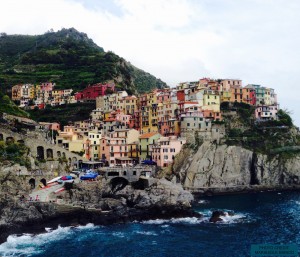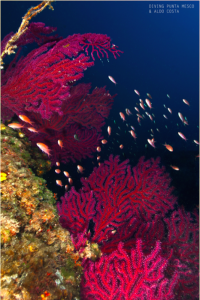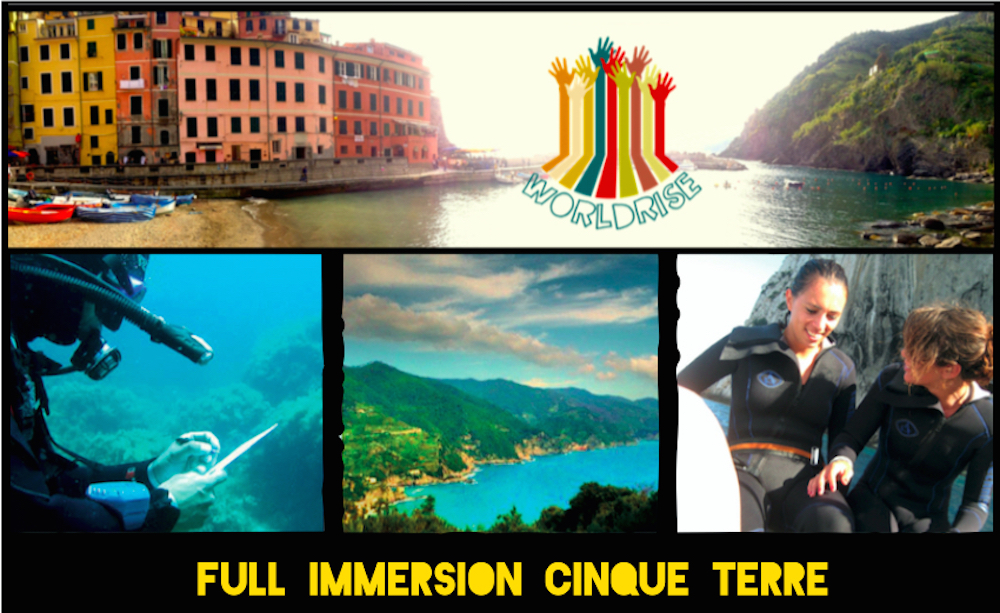Protecting Italy’s Underwater Treasure
February 7, 2015
By Mariasole Bianco, President of Worldrise (a new Mission Blue partner)
Cinque Terre is definitely one of the jewels in the crown of Italy. Riomaggiore, Manrola, Corniglia, Vernazza, and Monterosso are five pastel-hued little towns along the northwest coast of Italy; so romantic, so iconically Italian, that it seems that they were made to grace picture postcards.
If you ask, everyone will tell you that the main attraction of Cinque Terre is the magnificent landscape representing the harmonious interaction between people and nature. This is undeniably true, as the landscape illustrates a traditional way of life that has existed for 1,000 years – when stone wall terraces were built to colonize the steep hills and high cliffs of this area overlooking the Mediterranean.
The entire stone wall network has been calculated to be at least equal to the Great Wall of China and its creation. Through an enormous undertaking that lasted more than 200 years, this project was one of the main reasons why the area was declared a UNESCO World Heritage Site in 1997.
However, not everyone knows that there is another hidden gem in Cinque Terre of exceptional beauty and scenic quality: its astonishing and diverse underwater seascape.
The submerged morphology of the marine protected area, declared in 1997, is as varied as the morphology characterizing the land above the water with the coast plunging steeply into the sea with almost vertical cliffs as in Punta Mesco and in Capo Montenero. The Cinque Terre seabed is, for this reason, very deep and is one of the most varied and richest in terms of marine fauna in all of the Liguria region in northwestern Italy. Pelagic species of maigre, dentex and grouper as well as dolphins and whales call this area home.
The rocky coastal seabed, which characterizes almost the whole MPA (marine protected area), also hosts colonies of multicolored gorgonians, red corals and octopuses hiding between rocks.
The few sandy stretches of the coastal MPA are ideal substrata for Posidonia oceanica, an endemic seagrass species that is considered to be the real “lung” and life system for the Mediterranean marine environment. This superior plant has roots, stems and leaves and makes up meadows where it plays a fundamental role. By absorbing CO2 and oxygenating the water, it is the nursery of many Mediterranean species, acts an important biologic indicator of polluting agents, and it consolidates the substrata where it lives preventing coastal erosion.
To protect this underwater treasure, Worldrise – an Italian non-profit organization founded and run by young professionals – has designed and developed a project called “Full Immersion Cinque Terre.” The project is entirely managed and coordinated by Worldrise and established a partnership between MPA management authorities, diving centers that operate in the MPA and the University of Genova.

The project has two main components. The first one is based on education and on building awareness about the biological values of the reserve and the importance of their protection. Worldrise worked with the local marine park authority to develop an educational course for the diving centers to illustrate, in a simple and effective way, the values and the benefits of the MPA. Together with the course, an educational briefing summarized in an infographic was developed so that dive master and instructors could share their acquired knowledge with recreational divers and provide the interpretation and education needed to better understand and appreciate these biological values.
The second component is about capacity building and professional empowerment of university students studying environmental and marine sciences. During this project, the participating diving centers hosted a university student and provided diving certifications in exchange for the student’s volunteer work. The student helped with the duties of the diving center, supervised the educational briefing and was directly involved in all steps of the research project that assessed the economic benefits of the MPA for the local community.
The two components of this project may seam superfluous, but are not if considered within the Italian marine conservation context. Most of the MPAs in Italy have been established without any public consultation. Most of the time they are put in place with basic scientific assessment with insufficient education about the benefits of protecting the marine environment and with no community involvement – hence the need to improve education and to work in partnership with stakeholders.

Another problem that Italy faces is the fact that, due to the lack of government funding, universities mainly provide a theoretical education without integrating it with practical and professional preparation. The result is that youth unemployment in Italy reaches 44% – hence the need to involve students through effective capacity building opportunities.
Worldrise was born to provide solutions to these challenges. This project highlights how these objectives can be easily achieved. Worldrise develops and promotes marine conservation projects to foster the appreciation of environmental values. University students and recent graduated are directly involved and professionally empowered through these projects so that they can gain meaningful professional experience in environmental conservation and be empowered as emerging conservation leaders.
Learn more about Worldrise: www.worldrise.org









Great article! Good work!
Great work!! It’s amazing that such a beautiful area has great diving and MPAs. I’m an avid diver, will definitely be checking Worldrise out when we head to Cinque Terre if they allow non-uni students. 🙂